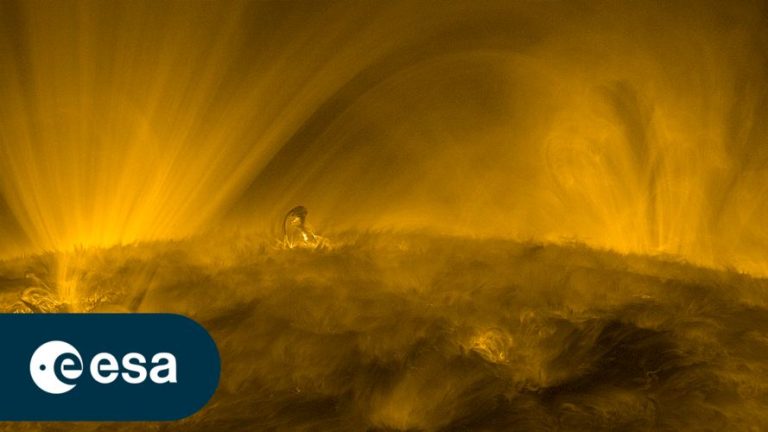Solar Orbiter Captures Astonishing Video of the Sun
Key Takeaway
The Solar Orbiter mission recorded an amazing video of the Sun. It shows the Sun’s detailed and active nature in a new way. This video provides new and deep understandings of how our closest star functions.
Summary
- The video, recorded by the Extreme Ultraviolet Imager (EUI) instrument on the Solar Orbiter spacecraft, shows the Sun appearing ‘fluffy’ due to plasma structures following magnetic field lines in the lower atmosphere.
- Coronal moss, resembling fine, lacy features, can be seen around sunspot groups, crossing the chromosphere and corona layers.
- Spicules, tall spires of gas reaching up to 10,000 km from the chromosphere, are visible on the solar horizon.
- The video captures the phenomenon of ‘coronal rain,’ where cooler, high-density plasma clumps fall back towards the Sun under gravity’s influence.
- A small eruption, larger than the Earth, is observed, with cooler material being lifted upwards before falling back down.
- The brightest regions in the video are around one million degrees Celsius, while cooler material appears darker as it absorbs radiation.
- The video offers an unprecedented view of the Sun’s dynamic surface features, thanks to the Solar Orbiter, Parker Solar Probe, and Solar Dynamics Observatory missions.
- These missions are helping astronomers gain deeper insights into the workings of the Sun, which powers our entire Solar System.
Solar Orbiter Captures Astonishing Video of the Sun
Have you ever imagined the Sun to be fluffy? Well, a mesmerizing video captured by the Solar Orbiter mission might just change your perception of our star forever. Recorded by the Extreme Ultraviolet Imager (EUI) instrument, this video offers an unprecedented glimpse into the intricate and dynamic features that adorn the Sun’s surface.
At first glance, the Sun appears to be covered in feathery, hair-like structures made of plasma. These structures follow the intricate patterns of magnetic field lines in the Sun’s lower atmosphere, creating a mesmerizing, almost fuzzy appearance. This is a visual manifestation of the complex interplay between the Sun’s plasma and its magnetic fields, a phenomenon that has long fascinated astronomers and astrophysicists.
Among the captivating features revealed in the video is the “coronal moss,” a term that might seem out of place when describing our blazing star. However, these fine, lacy structures bear an uncanny resemblance to the moss we find on Earth. Typically found around sunspot groups, where magnetic conditions are strong and large coronal loops form, the coronal moss spans two atmospheric layers: the chromosphere and the corona.
As the camera pans across the Sun’s horizon, one cannot help but notice the towering spires of gas known as “spicules.” rightly named for their spire-like appearance, these structures can reach staggering heights of up to 10,000 kilometers (6,000 miles) above the chromosphere, the Sun’s lower atmosphere.
At around the 0:30 mark in the video, a mesmerizing phenomenon unfolds: coronal rain. This celestial shower consists of cooler, higher-density clumps of plasma that, under the influence of gravity, fall back towards the Sun. While the coronal loops and surrounding regions bask in temperatures exceeding one million degrees Celsius, the coronal rain offers a stark contrast, with temperatures likely below 10,000 degrees Celsius.
In the middle of the captivating dance of plasma and magnetic fields, the video captures a small eruption at the center of the field of view, around the 0:20 mark. However, “small” is a relative term, as this eruption is larger than the Earth itself! The eruption showcases cooler material being lifted upwards before falling back down, offering a glimpse into the Sun’s turbulent and ever-changing nature.
The Solar Orbiter, along with other missions like the Parker Solar Probe and the Solar Dynamics Observatory, are providing astronomers with unprecedented views of the Sun, unlocking a wealth of knowledge about the dynamic ball of gas that powers our entire Solar System. Each observation, each video, and each image contributes to our understanding of the complex processes that shape our star and influence the vast expanse of space surrounding it.
HASHTAGS:
#SolarOrbiter, #Sun, #SolarPhysics, #SpaceExploration, #NASA, #ESA, #CoronalMoss, #Spicules, #CoronalRain, #SolarEruption, #SolarDynamics, #AstronomyMarvels
Source: ESA – European Space Agency Link: Watch the video

